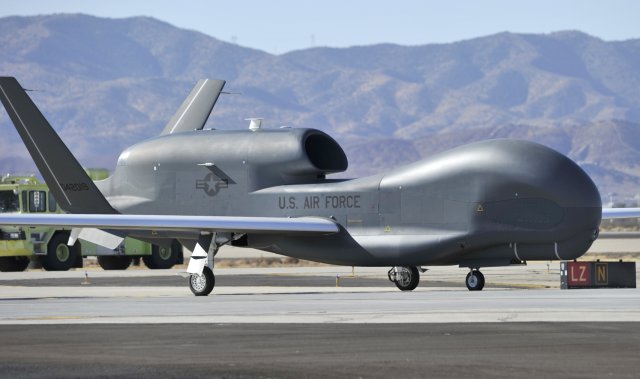 Two flights in February with a Senior Year Electro-Optical Reconnaissance System (SYERS)-2 intelligence gathering sensor strapped to a Block 30 Global Hawk were the first demonstrations by Northrop Grumman of its Universal Payload Adapter – a move toward creating one fleet of the unmanned aircraft to carry any sensor the US Air Force needs.
Two flights in February with a Senior Year Electro-Optical Reconnaissance System (SYERS)-2 intelligence gathering sensor strapped to a Block 30 Global Hawk were the first demonstrations by Northrop Grumman of its Universal Payload Adapter – a move toward creating one fleet of the unmanned aircraft to carry any sensor the US Air Force needs.
Northrop Grumman began development of the adapter in 2013 to move away from individual “block” versions of the massive drone, and take over the entire high-altitude intelligence, surveillance, and reconnaissance mission by being able to fly with the sensors used on the U-2.
Northrop has developed a 17-point system on the belly of a Global Hawk where specially created adapters would be able to attach several different sensor types, according to a demonstration of the adapter at AWS16.
Northrop Grumman’s innovative Universal Payload Adapter (UPA), a bracket that mounts to an existing Global Hawk airframe, allowing it to support a wide variety of payloads including the addition of legacy and future sensors. [Existing models of the U.S Air Force Global Hawk are capable of carrying an Enhanced Integrated Sensor Suite (EISS), Airborne Signals Intelligence Payload (ASIP) and Multi-Platform Radar Technology Insertion Program (MP-RTIP).]
The company plans to fly with the Optical Bar Camera, which is used by the U-2, and an MS-177 multi-spectral sensor later this year. Northrop is negotiating with the Air Force on the way forward to install the adapter to all 18 Block 30 Global Hawks in the service’s fleet and hopes to eventually move on to other models of the drone. The process would take between one to two months, though the biggest issue going forward is the operational demand on the Global Hawk fleet and the need for almost every aircraft to be available for missions, Jaggers said.
“This SYERS-2 flight is only the beginning. We firmly believe that with the addition of the UPA, Global Hawk is capable of flying any mission the U.S. Air Force requires,” said Mick Jaggers, vice president and program manager, Global Hawk unmanned aircraft system programs, Northrop Grumman. “Northrop Grumman is funding this study in order to prove that the system can affordably carry the same sensors as any other intelligence, surveillance and reconnaissance [ISR] aircraft. We look forward to continuing to work with our Air Force partners on this groundbreaking solution.”
Flight tests are taking place at Northrop Grumman’s Palmdale, California facility in cooperation with the U.S. Air Force. Northrop Grumman and the Air Force reached a Cooperative Research and Development Agreement (CRADA) last year that allows the company to test previously unavailable sensors on the Global Hawk.
Source: US Air Force; Press Release
